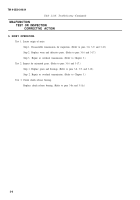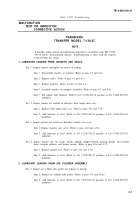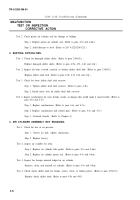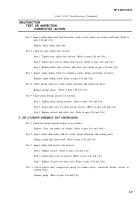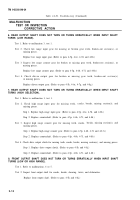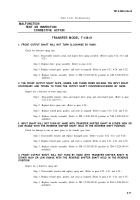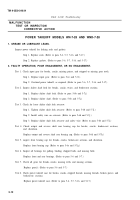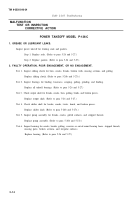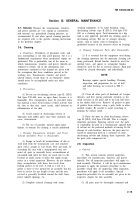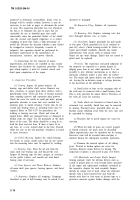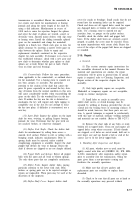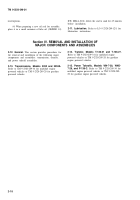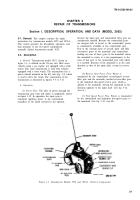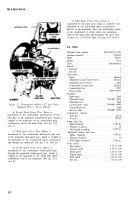TM-9-2520-246-34 - Page 33 of 153
TM 9-2520-246-34
inspected to determine serviceability. Some wear or
damage will be visually evident; however, it may be
necessary to use tools or gages to, determine the extent
of wear. The inspection procedure has two objectives:
the first is to eliminate any part or parts that are
unsuitable for use or doubtful parts that could
conceivably cause the premature failure of the rebuilt
unit; the second, and equally important, is to reduce
scrapping of parts that retain a high percentage of
useful life. Because the decision whether a part should
be scrapped or reused is frequently a matter of
judgment, this operation should be performed by
personnel experienced in the maintenance of
transmissions, transfers, and power takeoffs.
(3) Instructions for the removal of minor
imperfections and defects are included in this section
because they facilitate the inspection procedure. Every
part which requires it must be washed, rinsed, and
dried upon completion of the repair.
b. Inspection Procedure.
(1) Casting.
Inspect all gasket surfaces, all
bearing caps and shifter shaft covers. Remove any
burs, scratches, or gouges from these surfaces with a
hand-honing stone. Clean all burs or foreign material
from snapring grooves and expansion plug grooves.
Check the cases for cracks or small pin holes, paying
particular attention to areas that were marked for
attention prior to initial cleaning. Cracks that do not
extend into bearing bores or mounting holes may be
repaired. Refer to TM 9-237 for procedures for
welding or brazing cast iron. Check and clean all
tapped holes. Mark any damaged holes or damaged or
broken studs for repair. Try the gearshafts in the shaft
bores of the cases. The shafts should be a snug fit in
both the front and rear bore. If there is loose fit in
any bore, try a new, unused shaft in the bore. Discard
either the case or the old gearshaft, whichever is found
to cause looseness.
(2) Clutch Housing.
Inspect the clutch housing
for breaks or cracks. Small cracks that do not extend
into the mounting holes may be repaired by welding.
(3) Bearing Caps.
Press the oil seal from the
main shaft rear bearing cap, and discard the seal.
Inspect all bearing caps for burs, gouges, or scratches
on the gasket surface, and smooth out with hand-
honing stone if necessary.
(4) Gear Spacers and Thrust Washers.
Replace
all main shaft gear spacers, bearing spacers, and thrust
washers.
(5) Snaprings.
Replace all snaprings. Snaprings
furnished as part of ball bearings may be reused if not
distorted or damaged.
(6) Expansion Plugs.
Replace all expansion
plugs.
(7) Retaining Nuts.
Replace retaining nuts that
have damaged threads, cuts, or cracks.
(8) Gearshafts.
Inspect gearshafts for gall marks
or flat spots. Check gearshafts for fit as outlined in
para b(1) above. Check bearing-to-shaft fit. Refer to
repair and rebuild standards. Smooth any minor
imperfections with crocus cloth or honing stone.
Reject for any other damage. Shafts that are scored or
pitted must be replaced.
{9) Gears.
The experience and good judgment of
the inspector are required to a greater degree in
judging gears than in any other operation. It is not
possible to give arbitrary instructions as to when a
particular condition makes a gear unfit for further
use. The major and minor defects can only be pointed
out, leaving the in-between scrap or salvage decision
to the discretion of the individual.
(a) Small nicks or burs on the engaging ends of
the teeth may be removed with a small honing stone.
This is only practical for minor defects. Fractures of
the teeth are cause for rejection.
(b) Teeth which are fractured or burred must be
examined very carefully. Small burs may be removed
by honing. Fractured areas, provided there are no
hairline cracks radiating away from the area, may also
be smoothed by honing.
(c) Fractures due to metal fatigue are cause for
rejection.
(d) When the hubs of gears are scored, gouged,
or burred seriously, the gears must be discarded.
Minor imperfections may be smoothed out by honing.
Excessive wear will be revealed when end play is
checked during the subsequent assembly operations.
(e) Examine the internal splines of all sliding
gears. Twisted or broken splines are cause for
rejection. Remove minor defects by honing. The
inspection of splines is discussed in para (10) below.
(10) Mainshafts and Output Shafts.
Inspect
bearing journals; reject for obvious defects such as
scored or galled spots or wear beyond limits specified
in the repair and replacement standards contained in
the respective chapter for each assembly. Inspect
threads on output end of shaft. Clean any flattened
threads with a three-cornered file and wrap the
threads with three or four turns of friction tape as a
protective measure against further damage until the
2-16
Back to Top

